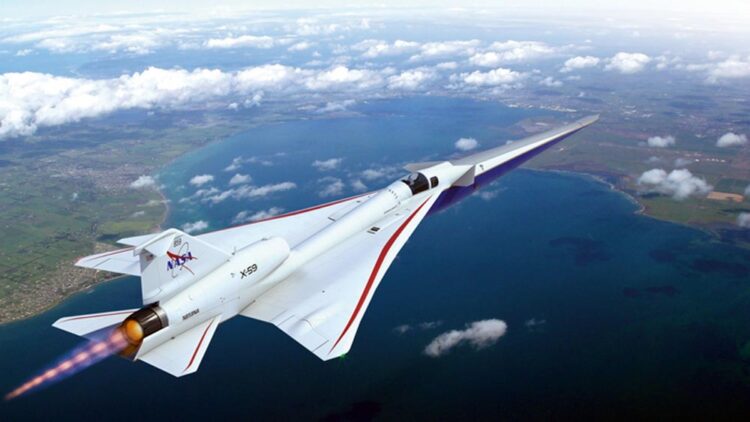Supersonic travel, without the sonic boom

NASA’s X-59 aircraft will fly over communities to test supersonic flight without the sonic boom.
Credit: NASA
The NASA Quesst mission will fly a supersonic aircraft over various communities to test noise-mitigating technology.
Supersonic aircraft generate a series of shock waves that merge into two distinct booms. The planes drag these incredibly loud sounds along their flight path, creating unacceptable noise levels over land. So far, sonic booms have prevented commercial supersonic flight over land, but fixing the noise could cut flight times in half.
At the 183rd Meeting of the Acoustical Society of America, Gautam Shah of NASA Langley Research Center will present “NASA Quesst Mission – Community Response Testing Plans,” in which he will discuss the plans to test a supersonic aircraft with technology to reduce sonic booms. The presentation will take place Dec. 6 at 10:50 a.m. Eastern U.S. in the Summit B room, as part of the meeting running Dec. 5-9 at the Grand Hyatt Nashville Hotel.
“NASA’s X-59 aircraft is intended to validate and demonstrate the design tools and technologies that make it possible to design an aircraft with a different shape that alters how supersonic shock waves behave,” said Shah. “Instead of coming together to be heard as a loud boom, the shock waves do not merge. They rapidly weaken, resulting in a sound more like a soft thump.”
NASA will conduct a series of flights over various communities across the U.S. Shah and his team will measure the sound of the aircraft and conduct public surveys to understand the public response to different noise levels. By providing this information to regulatory agencies, the group hopes to inform an overland supersonic sound standard.
The first flight will take place in 2023, followed by 18 months of testing to confirm the aircraft’s performance and safety. From 2025 through 2026, NASA intends to conduct a series of four to six community tests at locations across the country, eventually delivering the data to regulators in 2027.
More details can be found on the mission website. NASA has also developed a Quesst Mission Supersonic STEM Toolkit, which includes activities and educational material related to acoustics and flight.
MORE MEETING INFORMATION
Main meeting website: https://acousticalsociety.org/asa-meetings/
Technical program: https://eppro02.ativ.me/web/planner.php?id=ASAFALL22&proof=true
ASA PRESS ROOM
In the coming weeks, ASA’s Press Room will be updated with newsworthy stories and the press conference schedule at https://acoustics.org/asa-press-room/.
LAY LANGUAGE PAPERS
ASA will also share dozens of lay language papers about topics covered at the conference. Lay language papers are 300 to 500 word summaries of presentations written by scientists for a general audience. They will be accompanied by photos, audio, and video. Learn more at https://acoustics.org/lay-language-papers/.
PRESS REGISTRATION
ASA will grant free registration to credentialed and professional freelance journalists. If you are a reporter and would like to attend the meeting or virtual press conferences, contact AIP Media Services at media@aip.org. For urgent requests, AIP staff can also help with setting up interviews and obtaining images, sound clips, or background information.
ABOUT THE ACOUSTICAL SOCIETY OF AMERICA
The Acoustical Society of America (ASA) is the premier international scientific society in acoustics devoted to the science and technology of sound. Its 7,000 members worldwide represent a broad spectrum of the study of acoustics. ASA publications include The Journal of the Acoustical Society of America (the world’s leading journal on acoustics), JASA Express Letters, Proceedings of Meetings on Acoustics, Acoustics Today magazine, books, and standards on acoustics. The society also holds two major scientific meetings each year. See https://acousticalsociety.org/.
Media Contact
Ashley Piccone
American Institute of Physics
media@aip.org
Office: 301.209.3090
All latest news from the category: Physics and Astronomy
This area deals with the fundamental laws and building blocks of nature and how they interact, the properties and the behavior of matter, and research into space and time and their structures.
innovations-report provides in-depth reports and articles on subjects such as astrophysics, laser technologies, nuclear, quantum, particle and solid-state physics, nanotechnologies, planetary research and findings (Mars, Venus) and developments related to the Hubble Telescope.
Newest articles

Innovative 3D printed scaffolds offer new hope for bone healing
Researchers at the Institute for Bioengineering of Catalonia have developed novel 3D printed PLA-CaP scaffolds that promote blood vessel formation, ensuring better healing and regeneration of bone tissue. Bone is…

The surprising role of gut infection in Alzheimer’s disease
ASU- and Banner Alzheimer’s Institute-led study implicates link between a common virus and the disease, which travels from the gut to the brain and may be a target for antiviral…

Molecular gardening: New enzymes discovered for protein modification pruning
How deubiquitinases USP53 and USP54 cleave long polyubiquitin chains and how the former is linked to liver disease in children. Deubiquitinases (DUBs) are enzymes used by cells to trim protein…


